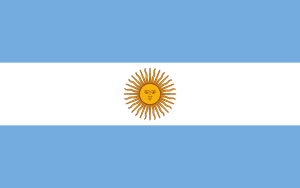
| Colors | HEX Code | RGB | CMYK |
|---|---|---|---|
| Sky Blue | #74ACDF | 116, 172, 223 | 48, 23, 0, 13 |
| White | #FFFFFF | 255, 255, 255 | 0, 0, 0, 0 |
| Gold | #F6B40E | 246, 180, 14 | 0, 27, 94, 4 |
The national flag of Argentina is made of three equal horizontal stripes. The light-blue band comes on top of the flag, while the middle stripe is white, and the third stripe is also blue. In the middle of the white stripe, there is a glowing yellow sun that has a face similar to a human face. It is known as the Sun of May, representing the Inca Sun.
Meaning of the Argentinian flag
The blue color in the Argentinian flag stands for the clear Andes sky, while the white stripe represents the snow on the top of the Andes mountain. The yellow sun in the middle represents the sun of May that was shining when the demonstrations started to end the Spanish rule over Argentina.
History of the Argentinian flag
The patriots in Argentina started a movement of demonstrations on May 25, 1810, to get independence from Spain. They wore cockades with white and blue ribbons. Later, General Manuel Belgrano, who was a political and military leader who led battles against the Spanish troops in his country Argentina, designed the celestial blue and white flag to use for military purposes on the battlefield. The striped flag was first hoisted on Feb.12, 1812, without the sun in the middle. Four years later, Argentina proclaimed its independence. In 1818, the sun was added to the flag. It is said that the sun supposedly was shining during the May demonstrations in 1810, and this is where the sun of May got its name and place on the flag of Argentina.
In 2010, there was a slight change to the blue color of the flag making it darker, and the design of the sun was also changed. The Argentinian flag has inspired many Central American flags like that of Uruguay, El Salvador and Nicaragua.